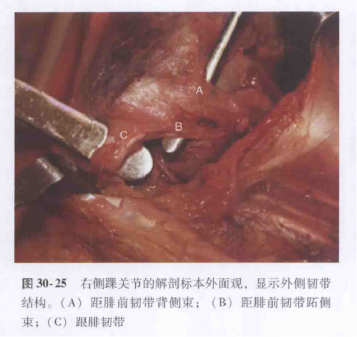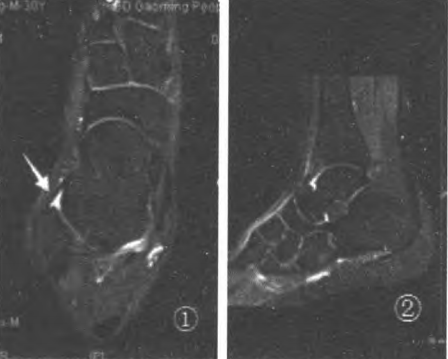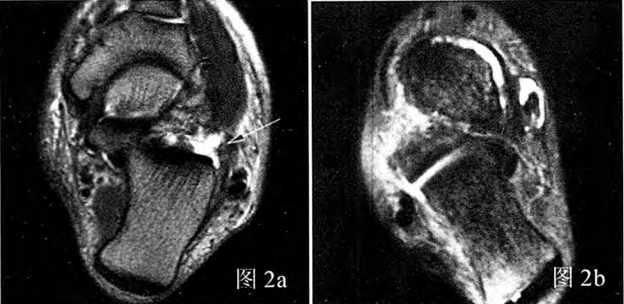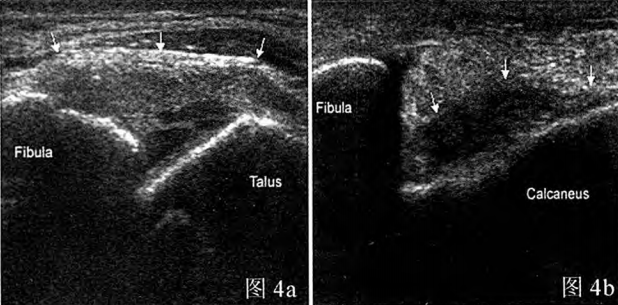פציעות בקרסול הן פציעת ספורט נפוצה המתרחשת בכ-25% מפציעות שריר-שלד, כאשר פציעות ברצועה הצידית הקולטיארטית (LCL) הן הנפוצות ביותר. אם המצב החמור אינו מטופל בזמן, קל להוביל לנקעים חוזרים, ומקרים חמורים יותר ישפיעו על תפקוד מפרק הקרסול. לכן, יש חשיבות רבה לאבחון ולטפל בפציעות של מטופלים בשלב מוקדם. מאמר זה יתמקד במיומנויות האבחון של פציעות ברצועה הצידית הקולטיארטית של מפרק הקרסול כדי לסייע לרופאים לשפר את דיוק האבחון.
א. אנטומיה
רצועה טלופיבולרית קדמית (ATFL): שטוחה, מחוברת לקפסולה הצידית, מתחילה לפני הפיבולה ומסתיימת לפני גוף הטלוס.
רצועה קלקנו-פיבולרית (CFL): בצורת חוט, שמקורה בגבול הקדמי של עצם המלאולוס הצידית הדיסטלית ומסתיימת בעצם העקב.
רצועה טלופיבולרית אחורית (PTFL): מקורה על המשטח המדיאלי של המלאולוס הצידי ומסתיימת מאחורי הטלוס המדיאלי.
פציעות ATFL לבדן היו אחראיות לכ-80% מהפציעות, בעוד שפציעות ATFL בשילוב עם פציעות CFL היו אחראיות לכ-20%.



תרשים סכמטי ותרשים אנטומי של הרצועה הביטחונית הצידית של מפרק הקרסול
II. מנגנון הפגיעה
פגיעות סובינציה: רצועה טלופיבולרית קדמית
פגיעה ברצועה הקלקנופיבולרית: רצועה קלקנופיבולרית

ג. דירוג פגיעה
דרגה א': מתיחה ברצועה, ללא קרע ברצועה נראה לעין, לעיתים רחוקות נפיחות או רגישות, וללא סימנים של אובדן תפקוד;
דרגה II: קרע מקרוסקופי חלקי של הרצועה, כאב בינוני, נפיחות ורגישות, ופגיעה קלה בתפקוד המפרק;
דרגה ג': הרצועה קרועה לחלוטין ומאבדת את שלמותה, מלווה בנפיחות משמעותית, דימום ורגישות, מלווים באובדן תפקוד ניכר וביטויים של חוסר יציבות במפרק.
IV. בדיקה קלינית מבחן מגירה קדמית


המטופל יושב כאשר הברך כפופה וקצה השוק משתלשל, והבודק מחזיק את עצם השוקה במקומה ביד אחת ודוחף את כף הרגל קדימה מאחורי העקב ביד השנייה.
לחלופין, המטופל שוכב על הגב או יושב כאשר הברך כפופה בזווית של 60 עד 90 מעלות, העקב מקובע לקרקע, והבודק מפעיל לחץ אחורי על עצם השוקה הדיסטלית.
תוצאה חיובית מנבאת קרע ברצועה הטלופיבולרית הקדמית.
מבחן מאמץ היפוך

הקרסול הפרוקסימלי קובע, ומאמץ וארוס הופעל על הקרסול הדיסטלי כדי להעריך את זווית הטיה של הטלוס.

בהשוואה לצד הנגדי, >5° חיובי באופן מחשיד, ו >10° חיובי; או >15° חד צדדי חיובי.
מנבא חיובי לקרע ברצועה הקלקנופיבולרית.
בדיקות הדמיה

צילומי רנטגן של פציעות ספורט נפוצות בקרסול

צילומי רנטגן שליליים, אך MRI מראה קרעים ברצועות הטלופיבולריות הקדמיות והקלנופיבולריות.
יתרונות: צילום רנטגן הוא הבחירה הראשונה לבדיקה, שהיא חסכונית ופשוטה; היקף הפגיעה נשפט על ידי הערכת מידת נטיית הטאלוס. חסרונות: תצוגה לקויה של רקמות רכות, במיוחד של מבנים רצועיים החשובים לשמירה על יציבות המפרק.
MRI

איור 1. מיקום אלכסוני של 20° הראה את הרצועה הטלופיבולרית הקדמית הטובה ביותר (ATFL); איור 2. קו אזימוט של סריקת ATFL

תמונות MRI של פגיעות שונות ברצועה הטלופיבולרית הקדמית הראו כי: (א) עיבוי ובצקת ברצועה הטלופיבולרית הקדמית; (ב) קרע ברצועה הטלופיבולרית הקדמית; (ג) קרע ברצועה הטלופיבולרית הקדמית; (ד) פגיעה ברצועה הטלופיבולרית הקדמית עם שבר אווולסיה.

איור 3. המיקום האלכסוני של -15° הראה את הרצועה הקלקנו-פיבולרית (CFI) הטובה ביותר;
איור 4. אזימוט סריקת CFL

קרע חריף ומלא של הרצועה הקלקנופיבולרית

איור 5: מבט קורונלי מראה את הרצועה הטלופיבולרית האחורית הטובה ביותר (PTFL);
איור 6 אזימוט סריקת PTFL

קרע חלקי של הרצועה הטלופיבולרית האחורית
דירוג האבחון:
דרגה א': אין נזק;
דרגה II: חבלה ברצועות, רציפות מרקם טובה, עיבוי רצועות, היפואכוגניות, בצקת של הרקמות הסובבות;
דרגה ג': מורפולוגיה לא שלמה של הרצועות, דילול או שיבוש חלקי של רציפות המרקם, עיבוי הרצועות וסיגנל מוגבר;
דרגה IV: שיבוש מוחלט של רציפות הרצועה, אשר עשוי להיות מלווה בשברי אוולציה, עיבוי רצועות ועלייה באות מקומי או מפושט.
יתרונות: רזולוציה גבוהה של רקמות רכות, תצפית ברורה על סוגי פגיעות ברצועות; ניתן להראות נזק לסחוס, חבלה בעצם ואת המצב הכללי של פגיעה מורכבת.
חסרונות: לא ניתן לקבוע במדויק האם שברים ונזק לסחוס המפרקי נקטעו; בשל מורכבות רצועות הקרסול, יעילות הבדיקה אינה גבוהה; יקר וגוזל זמן.
אולטרסאונד בתדר גבוה

איור 1א': פגיעה ברצועה הטלופיבולרית הקדמית, קרע חלקי; איור 1ב': הרצועה הטלופיבולרית הקדמית קרועה לחלוטין, הגדם מעובה, ונראה תפליט גדול בחלל הצידי הקדמי.

איור 2א': פגיעה ברצועה הקלקנופיבולרית, קרע חלקי; איור 2ב': פגיעה ברצועה הקלקנופיבולרית, קרע מלא

איור 3א: רצועה טלופיבולרית קדמית תקינה: תמונת אולטרסאונד המציגה מבנה היפואקוי אחיד בצורת משולש הפוך; איור 3ב: רצועה קלקניופיבולרית תקינה: מבנה סיבי צפוף ואקוגני בינוני בתמונת אולטרסאונד

איור 4א': קרע חלקי של הרצועה הטלופיבולרית הקדמית בתמונת אולטרסאונד; איור 4ב': קרע מלא של הרצועה הקלקנופיבולרית בתמונת אולטרסאונד
דירוג האבחון:
חבלה: תמונות אקוסטיות מראות מבנה שלם, רצועות מעובה ונפוחות; קרע חלקי: ישנה נפיחות ברצועה, ישנה שיבוש מתמשך של חלק מהסיבים, או שהסיבים דקים מקומית. סריקות דינמיות הראו כי מתח הרצועה נחלש משמעותית, והרצועה דלילה וגדלה והאלסטיות נחלשה במקרה של ולגוס או וארוס.
קרע שלם: רצועה שנקטעה לחלוטין ומתמשכת עם הפרדה דיסטלית, סריקה דינמית מצביעה על חוסר מתח ברצועה או קרע מוגבר, ובמפרק ולגוס או וארוס, הרצועה נעה לקצה השני, ללא כל גמישות ועם מפרק רפוי.
יתרונות: עלות נמוכה, קל לתפעול, לא פולשני; המבנה העדין של כל שכבה של רקמה תת עורית מוצג בבירור, מה שתורם לתצפית על נגעים ברקמת השרירים והשלד. בדיקת חתך שרירותית, בהתאם לחגורת הרצועות כדי לעקוב אחר כל תהליך הרצועה, מבהירה את מיקום הפגיעה ברצועה, ונצפים באופן דינמי את מתח הרצועה והשינויים המורפולוגיים.
חסרונות: רזולוציה נמוכה יותר של רקמות רכות בהשוואה ל-MRI; הסתמכות על תפעול טכני מקצועי.
בדיקת ארתרוסקופיה

יתרונות: התבוננות ישירה במבנים של עצם המליאולוס הצידית וכף הרגל האחורית (כגון מפרק הטלר התחתון, הרצועה הטלופיבולרית הקדמית, הרצועה הקלקנופיבולרית וכו') כדי להעריך את שלמות הרצועות ולסייע למנתח לקבוע את תוכנית הניתוח.
חסרונות: פולשני, עלול לגרום לסיבוכים מסוימים, כגון נזק עצבי, זיהום וכו'. הוא נחשב בדרך כלל לסטנדרט הזהב לאבחון פגיעות ברצועות וכיום משמש בעיקר לטיפול בפגיעות ברצועות.
זמן פרסום: 29 בספטמבר 2024










